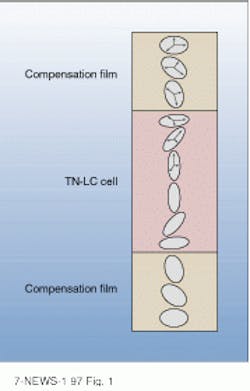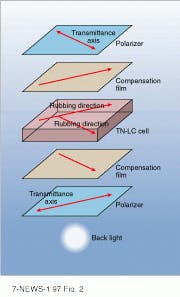Twisted-nematic liquid-crystal displays (TN-LCDs) have two major disadvantages when being viewed by more than one person. The viewing angle of the display is limited, and there are gray-level "inversion zones" in which black becomes white and vice versa. Researchers at the Fuji Photo Film Company Ashigara Research Laboratories (Kanagawa, Japan) have developed a method of pre- and postcompensating for the birefringence of liquid crystal, thereby increasing the viewing angle but without sacrificing brightness.
The link between birefringence and viewing angle in a TN-LCD is not obvious. Displays are generally backlit with a wide-angle light source. The light first passes through a polarizer that discards about half of it and allows the remainder to pass. This light is now polarized parallel to the direction of the liquid-crystal alignment at the bottom of the liquid-crystal cell. The orientation of the crystal changes gradually, however, twisting and tilting so that the alignment at the top of the cell is perpendicular to that at the bottom. The polarization of the light will be rotated with the orientation of the liquid-crystal molecules. The light can then emerge through a polarizer at the top of the cell, which is crossed with the polarizer at the bottom.
This technique only works properly, however, for light coming in at right angles to the cell. Though light entering at, say, 30 has the same nominal polarization as the light that is normally incident—because it passed through the same polarizer—the 30 light experiences the liquid-crystal cell very differently. The polarization components are effectively tilted and so are not as compatible with the birefringence of the tilted, twisted-nematic liquid-crystal molecules. Instead of being neatly turned, the polarization of wide-angle light can be severely skewed by the cell, with perpendicularly polarized components being "pulled" in different directions. Such unwanted manipulation means that much less of this light makes it through the second polarizer and so into the corresponding output angle for the display.
The only way to work around this problem is to make the light travel through the same kind of chemical structure but with opposite (negative) birefringence properties (see Fig. 1). In this way, any polarization skew can be inverted and subsequently neutralized. Fuji researcher Hiroyuki Mori has accomplished this by using a negatively birefringent discotic compound—a substance made up of disk-shaped molecules—and tilting them to emulate the liquid-crystal structure.1,2 The "twist" is achieved by "crossing" the films—matching their orientations to the rubbing (alignment) direction of the top and bottom of the liquid-crystal cell (see Fig. 2).By using the compensator film, Mori was able to enhance the vertical and horizontal view zones of a TN-LCD and completely eliminate the upper inversion zone. For instance, the upward vertical angle at which the contrast ratio dropped to 10 (from 100) increased from about 25 with a normal display to 40. The lower inversion zone, which could appear when viewed from almost any angle below the normal, was pushed down so that it could never be seen above -20. It could not be eliminated, however, because the compensation film is not active and cannot, therefore, compensate for pixels that are off.
Though making the compensation film switchable is not currently being researched, other improvements are possible. In particular, Mori's simulations show that birefringence compensation would be more effective if the "twist" of the compensator more accurately imitated that of the liquid crystal.
REFERENCES
1. H. Mori, Jap. J. Appl. Phys. 36, Part 1, No. 1A, 143 (January 1997).
2. H. Mori, Jap. J. Appl. Phys. 36, Part 1, No. 3A, 1068 (March 1997).
About the Author
Sunny Bains
Contributing Editor
Sunny Bains is a contributing editor for Laser Focus World and a technical journalist based in London, England.

